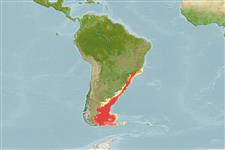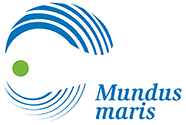Merluccius hubbsi Marini, 1933
Argentine hake
Ajouter votre observation dans Fish Watcher
| Native range | All suitable habitat | Point map | Year 2050 |

|
| This map was computer-generated and has not yet been reviewed. |
| Merluccius hubbsi AquaMaps Data sources: GBIF OBIS |
Envoyez vos Photos et vidéos
Pictures | Images GoogleMerluccius hubbsi
Picture by INIDEP
Pictures | Images GoogleMerluccius hubbsi
Picture by INIDEP
Argentina country information
Common names:
Merluza, Merluza argentina, Merluza bonaerense
Occurrence: native
Salinity: marine
Abundance: | Ref:
Importance: highly commercial | Ref: FAO, 1994
Aquaculture: | Ref:
Regulations: | Ref:
Uses: no uses
Comments: Ranges south to the Patagonian region (Ref. 27363). Center of abundance of this species is the Bonaelensis area (Ref. 27363). Marketed fresh (Ref. 1371). Also Ref. 8984.
National Checklist: Argentina
Country Information: https://www.cia.gov/library/publications/resources/the-world-factbook/geos/ar.html
National Fisheries Authority:
Occurrences: Occurrences Point map
Main Ref: Cohen, D.M., T. Inada, T. Iwamoto and N. Scialabba, 1990
National Database:
Occurrence: native
Salinity: marine
Abundance: | Ref:
Importance: highly commercial | Ref: FAO, 1994
Aquaculture: | Ref:
Regulations: | Ref:
Uses: no uses
Comments: Ranges south to the Patagonian region (Ref. 27363). Center of abundance of this species is the Bonaelensis area (Ref. 27363). Marketed fresh (Ref. 1371). Also Ref. 8984.
National Checklist: Argentina
Country Information: https://www.cia.gov/library/publications/resources/the-world-factbook/geos/ar.html
National Fisheries Authority:
Occurrences: Occurrences Point map
Main Ref: Cohen, D.M., T. Inada, T. Iwamoto and N. Scialabba, 1990
National Database:
Common names from other countries
Classification / Names Noms communs | Synonymes | Catalog of Fishes(Genre, Espèce) | ITIS | CoL | WoRMS | Cloffa
> Gadiformes (Cods) > Merlucciidae (Merluccid hakes)
Etymology: Merluccius: Latin, mar, maris = the sea + Latin, lucius = pike (Ref. 45335).
Eponymy: Professor Carl Levitt (Leavitt) Hubbs (1894–1979) was a giant of American ichthyology. [...] (Ref. 128868), visit book page.
Etymology: Merluccius: Latin, mar, maris = the sea + Latin, lucius = pike (Ref. 45335).
Eponymy: Professor Carl Levitt (Leavitt) Hubbs (1894–1979) was a giant of American ichthyology. [...] (Ref. 128868), visit book page.
Environment: milieu / climate zone / depth range / distribution range Écologie
marin benthopélagique; océanodrome (Ref. 51243); profondeur 50 - 800 m (Ref. 9715), usually 100 - 200 m (Ref. 1371). Temperate; 20°S - 56°S, 69°W - 40°W (Ref. 58452)
Distribution Pays | Zones FAO | Écosystèmes | Occurrences | Point map | Introductions | Faunafri
Southwest Atlantic: off southern Brazil to Argentina and the Falkland Islands up to 54°S (Ref. 47377).
Length at first maturity / Taille / Poids / Âge
Maturity: Lm 30.4 range ? - ? cm
Max length : 95.0 cm TL mâle / non sexé; (Ref. 1371); common length : 50.0 cm TL mâle / non sexé; (Ref. 1371); common length :60 cm TL (female); âge max. reporté: 6 années (Ref. 83871)
Max length : 95.0 cm TL mâle / non sexé; (Ref. 1371); common length : 50.0 cm TL mâle / non sexé; (Ref. 1371); common length :60 cm TL (female); âge max. reporté: 6 années (Ref. 83871)
Description synthétique Clés d'identification | Morphologie | Morphométrie
Épines dorsales (Total) : 1; Rayons mous dorsaux (Total) : 43 - 52; Épines anales: 0; Rayons mous anaux: 36 - 41; Vertèbres: 50 - 53. Gill rakers short and thick with blunt tips. Pectoral fins relatively short, not reaching level of anal fin origin. Color is silvery with golden luster on back, silvery white on belly (Ref. 1371).
Adults inhabit continental shelf depths mainly between 100 and 200 m (Ref. 1371). Larger individuals feed on fish (anchovies, hake, nototheniids, myctophids and Southern blue whitings), squids and macrozooplankton (euphausiids and amphipods); smaller individuals feed on mysids and amphipods (Ref. 1371). Migrate inshore during spring and summer, and offshore into deep water wintering areas after spawning; also undertake diel vertical migrations (Ref. 1371). Sold fresh and frozen.
Life cycle and mating behavior Maturité | Reproduction | Frai | Œufs | Fécondité | Larves
An indeterminate batch spawner.
Référence principale
Upload your references | Références | Coordinateur | Collaborateurs
Cohen, D.M., T. Inada, T. Iwamoto and N. Scialabba, 1990. FAO species catalogue. Vol. 10. Gadiform fishes of the world (Order Gadiformes). An annotated and illustrated catalogue of cods, hakes, grenadiers and other gadiform fishes known to date. FAO Fish. Synop. 125(10). Rome: FAO. 442 p. (Ref. 1371)
Menace pour l'homme
Harmless
Utilisations par l'homme
Pêcheries: hautement commercial; pêche sportive: oui
FAO(pêcheries: production, Résumé espèce; publication : search) | FishSource | Sea Around Us
Plus d'informations
Trophic ecology
Éléments du régime alimentaire
Composition du régime alimentaire
Consommation alimentaire
Food rations
Prédateurs
Éléments du régime alimentaire
Composition du régime alimentaire
Consommation alimentaire
Food rations
Prédateurs
Population dynamics
Paramètres de croissance
Max. ages / sizes
Length-weight rel.
Length-length rel.
Fréquences de longueurs
Mass conversion
Recrutement
Abondance
Paramètres de croissance
Max. ages / sizes
Length-weight rel.
Length-length rel.
Fréquences de longueurs
Mass conversion
Recrutement
Abondance
Life cycle
Reproduction
Maturité
Fécondité
Frai
Spawning aggregations
Œufs
Développement de l'œuf
Larves
Dynamique des populations larvaires
Reproduction
Maturité
Fécondité
Frai
Spawning aggregations
Œufs
Développement de l'œuf
Larves
Dynamique des populations larvaires
Anatomy
Surface branchiale
Brain
Otolith
Surface branchiale
Brain
Otolith
Physiology
Body composition
Nutrients
Consommation d'oxygène
Type de nage
Vitesse de nage
Visual pigments
Fish sound
Diseases & Parasites
Toxicity (LC50s)
Body composition
Nutrients
Consommation d'oxygène
Type de nage
Vitesse de nage
Visual pigments
Fish sound
Diseases & Parasites
Toxicity (LC50s)
Genetics
Génétique
Heterozygosity
Héritabilité
Génétique
Heterozygosity
Héritabilité
Human related
Aquaculture systems
Profils d'aquaculture
Souches
Ciguatera cases
Stamps, coins, misc.
Aquaculture systems
Profils d'aquaculture
Souches
Ciguatera cases
Stamps, coins, misc.
Outils
E-book | Guide de terrain | Clés d'identification | Générateur de fréquences de longueur | Outil de dynamique de population | Carte par point | Classification Tree
| Catch-MSY |
Articles particuliers
Télécharger en XML
Sources Internet
Aquatic Commons | BHL | Cloffa | BOLDSystems | Websites from users | FishWatcher | CISTI | Catalog of Fishes(Genre, Espèce) | DiscoverLife | ECOTOX | Faunafri | Fishtrace | GenBank(génôme, nucléotide) | GloBI | GOBASE | | Google Books | Google Scholar | Google | IGFA World Record | MitoFish | Bases de données nationales | Otolith Atlas of Taiwan Fishes | PubMed | Reef Life Survey | Scirus | SeaLifeBase | Arbre de Vie | Wikipedia(aller à, chercher) | World Records Freshwater Fishing | Zoobank | Zoological Record
Estimates based on models
Preferred temperature (Ref. 115969): 4.5 - 18, mean 6.3 (based on 214 cells).
Phylogenetic diversity index (Ref. 82804): PD50 = 0.5000 [Uniqueness, from 0.5 = low to 2.0 = high].
Bayesian length-weight: a=0.00479 (0.00402 - 0.00570), b=3.10 (3.05 - 3.15), in cm Total Length, based on LWR estimates for this species (Ref. 93245).
Niveau trophique (Ref. 69278): 4.0 ±0.61 se; based on food items.
Résilience (Ref. 120179): Faible, temps minimum de doublement de population : 4,5 à 14 années (K=0.13-0.19; tm=6).
Prior r = 0.42, 95% CL = 0.27 - 0.62, Based on 4 data-limited stock assessments.
Fishing Vulnerability (Ref. 59153): High vulnerability (61 of 100).
Climate Vulnerability (Ref. 125649): Moderate vulnerability (44 of 100).




